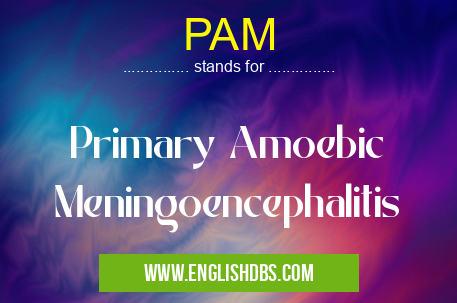What does PAM mean in DISEASES
Primary Amoebic Meningoencephalitis (PAM) is a rare but fatal infection of the central nervous system caused by free-living amoebas, specifically Naegleria fowleri. It is a rapidly progressive disease characterized by severe headache, fever, nausea, vomiting, and stiff neck.

PAM meaning in Diseases in Medical
PAM mostly used in an acronym Diseases in Category Medical that means Primary Amoebic Meningoencephalitis
Shorthand: PAM,
Full Form: Primary Amoebic Meningoencephalitis
For more information of "Primary Amoebic Meningoencephalitis", see the section below.
Transmission
PAM is typically transmitted through contact with contaminated water, such as:
- Swimming in warm, freshwater lakes or rivers
- Diving or jumping in shallow water
- Using contaminated water for nasal irrigation or religious rituals
Symptoms
The incubation period for PAM is typically 1-7 days. Initial symptoms resemble those of bacterial meningitis, including:
- Severe headache
- Fever
- Nausea
- Vomiting
- Stiff neck
- Sensitivity to light
As the disease progresses, it can lead to:
- Altered mental status
- Seizures
- Coma
- Death
Diagnosis
Diagnosing PAM is challenging due to its rarity and overlap with other conditions. It requires:
- A thorough patient history and physical examination
- Examination of cerebrospinal fluid (CSF) under a microscope
- Molecular testing to detect Naegleria fowleri DNA
Treatment
PAM is a medical emergency and requires immediate treatment. Treatment options include:
- Antifungal medications (e.g., amphotericin B)
- Antiparasitic medications (e.g., miltefosine)
- Supportive care (e.g., mechanical ventilation, fluid management)
Prevention
Prevention of PAM focuses on avoiding contact with contaminated water:
- Swim in well-maintained pools or treated swimming areas
- Avoid diving or jumping in shallow water
- Use sterile water for nasal irrigation and religious rituals
Essential Questions and Answers on Primary Amoebic Meningoencephalitis in "MEDICAL»DISEASES"
What is Primary Amoebic Meningoencephalitis (PAM)?
PAM is a rare but fatal infection of the brain and spinal cord caused by the single-celled organism Naegleria fowleri. It is commonly found in warm freshwater bodies like lakes, rivers, and hot springs.
How is PAM transmitted?
PAM is typically contracted when contaminated water enters the nose during recreational activities like swimming, diving, or water skiing. The amoeba then travels through the olfactory nerve to the brain.
What are the symptoms of PAM?
Symptoms can develop within days after exposure and include:
- Headache
- Fever
- Nausea
- Vomiting
- Stiff neck
- Seizures
- Confusion
- Death
How is PAM diagnosed?
PAM can be difficult to diagnose as its symptoms resemble those of other infections. A lumbar puncture (spinal tap) is typically performed to collect cerebrospinal fluid for testing.
Is PAM treatable?
Treatment options for PAM are limited and often ineffective. Medications like miltefosine and amphotericin B may be used, but their success rate is low.
How can PAM be prevented?
To reduce the risk of PAM:
- Avoid swimming or diving in warm, stagnant water.
- Use nose clips or plugs when swimming in potentially contaminated water.
- Boil or filter water before drinking or irrigating nasal passages.
Final Words: Primary Amoebic Meningoencephalitis (PAM) is a rare but devastating infection that requires early recognition and prompt treatment. By understanding the transmission, symptoms, and prevention measures, individuals can reduce their risk of contracting this disease.
